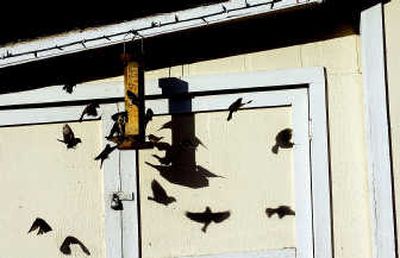Library stays in tune with birds

What do movies like “The Incredibles,” “Harry Potter,” “Raiders of the Lost Ark,” “Mosquito Coast,” “The New World,” and “Ratatouille” have in common? These movies all contain bird sounds. And when Hollywood needs authentic bird sounds, or wants to create make-believe creatures out of authentic sounds, they contact the Macaulay Library.
The Macaulay Library houses the largest collection of sounds from nature – more than 165,000 recordings. The library is part of the Cornell Lab of Ornithology – an organization focused on educating citizens about birds.
The Cornell Lab of Ornithology and the Macaulay Library had their start in the early 1900s. Interest in birds and behavior was prevalent at Cornell University in Ithaca, N.Y., and two bird enthusiasts, painter Louis Agassiz Fuertes and researcher, Arthur Augustus Allen, led the region and the country in the field of ornithology – the study of birds. In 1915, Allen became the first Assistant Professor of Ornithology in the United States. His classes trained many of today’s well-known ornithologists. Allen worked with students and colleagues for years on documenting and recording bird sounds and behavior.
In the 1950s, Fuertes and Allen recruited a professional librarian to organize the growing collection. At the same time, Allen had a popular radio show called “Know Your Birds.” It was his goal and desire to educate the public about birds. Allen was instrumental in putting ornithology at the forefront of Cornell University. In 1955, the CLO became an independent department at Cornell, and in 1957, the Stuart Observatory was completed. It housed a library of natural sounds which has become the world-renowned archive known today as the Macaulay Library.
So what is the purpose of CLO and all these sound recordings? According to Mary Guthrie, production manager of the Macaulay Library, “The main purpose is to raise money for conservation. Birds are a vehicle for people to care about their environment.”
Whether you’re a beginner or an avid birder, a teacher, student, parent, grandparent or a scientist, there is something for everyone at CLO and the Macaulay Library, and there are many ways to get involved. You can join Project Feeder Watch, the Great Backyard Bird Count, The Birdhouse Network, eBird, Bird Sleuth and more. Or perhaps you’d prefer to just listen and enjoy audio and videos of birds on line – it’s all available.
You can even sponsor a classroom to get local children more involved, and for teachers and classrooms, there is a plethora of information available – no birding experience necessary. Guthrie says it is an “interactive science exploration” that gets kids comfortable with science.”
With educational outreach as their focus, CLO’s main department is called Citizen Science. Citizen Science is guiding people all across the United States to learn, gather, and submit data about birds, and everyone is welcome.
Guthrie says, “Don’t worry about errors, even if you only know a robin. You will get a lot of information when you decide to participate and join one of the projects.”
Each Citizen Science project gives easy instructions on how to count birds and record information. All data submitted to CLO and its partners contributes valuable information for furthering bird conservation and population monitoring efforts.
So, if you’re going to see “Ratatouille” this summer, or are catching up on some of the earlier “Harry Potter” or “Raiders” films, keep an ear out for bird sounds. Having an ear for birds is another joy of bird watching, and there’s no better place to train your ear than by exploring CLO and the Macaulay Library.